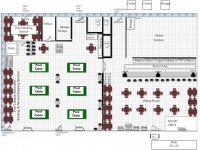I need a little help with a mathematical equation regarding pool tables and how far and at what speed a ball travels after it leaves the table.
I am opening up a Restaurant/Bar/Pool Room and the City wants me to have pool tables 16' away from any seating. YEAH, more old school pool law BS. Anyway, I have to prove to them or at least show them that this is a ridiculous amount of distance.
What I need to know is, if a pool ball leaves the table how far can it be expected to travel in the air and at what speed. I know from break contests the average speed a pool ball can travel is about 25mph. But given it's weight and trajectory how far would it travel and what would the speeds be per foot of travel and what would the drop or decline in elevation be per foot?
Any help with this would be great.
Also, if anyone knows any city/state laws regarding this I could use for case law please let me know.
Thanks in advance for any info you can provide.
Attached is the proposed floor plan.
I am opening up a Restaurant/Bar/Pool Room and the City wants me to have pool tables 16' away from any seating. YEAH, more old school pool law BS. Anyway, I have to prove to them or at least show them that this is a ridiculous amount of distance.
What I need to know is, if a pool ball leaves the table how far can it be expected to travel in the air and at what speed. I know from break contests the average speed a pool ball can travel is about 25mph. But given it's weight and trajectory how far would it travel and what would the speeds be per foot of travel and what would the drop or decline in elevation be per foot?
Any help with this would be great.
Also, if anyone knows any city/state laws regarding this I could use for case law please let me know.
Thanks in advance for any info you can provide.
Attached is the proposed floor plan.
Attachments
Last edited:
